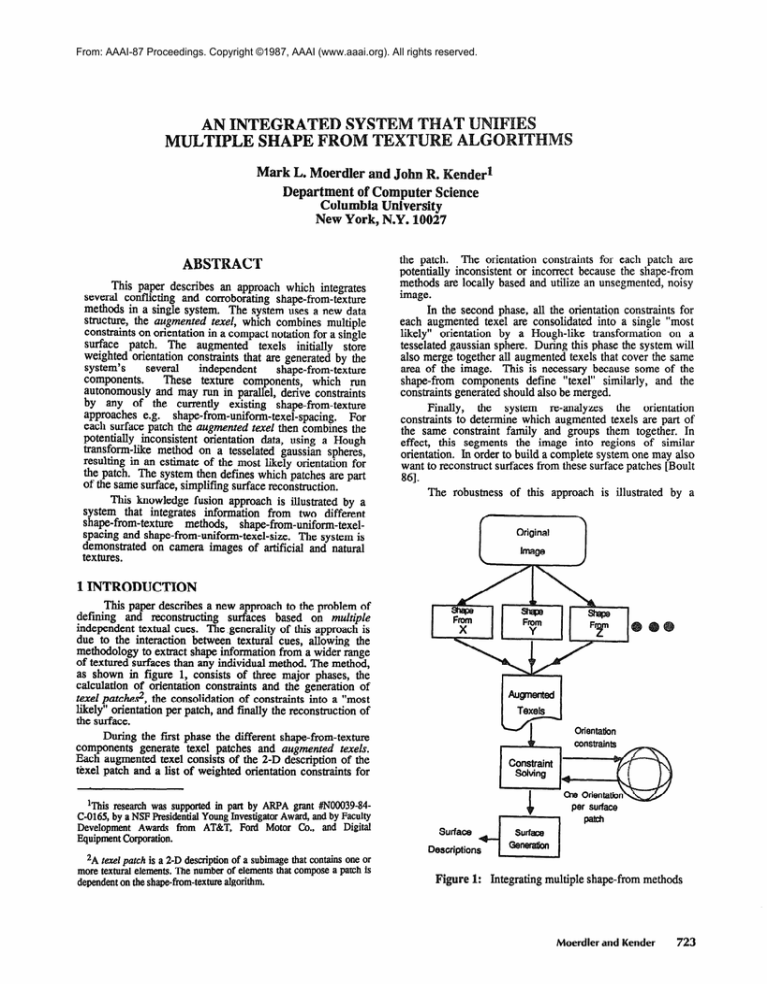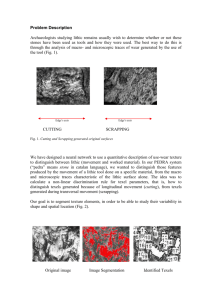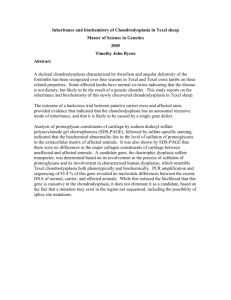
From: AAAI-87 Proceedings. Copyright ©1987, AAAI (www.aaai.org). All rights reserved.
Department of Computer Science
Columbia University
New York, N.Y. 10027
This paper describes an approach which integrates
several conflicting and corroborating shape-from-texture
methods in a single system. The system uses a new data
structure, the augmented texel, which combines multiple
constraints on orientation in a compact notation for a single
surface patch. The augmented texels initially store
weighted orientation constraints that are generated by the
system’s
several
independent
shape-from- texture
components.
These texture components, which run
autonomously and may run in parallel, derive constraints
by any of the currently existing shape-from-texture
approaches e.g. shape-from-uniform-texel-spacing.
For
each surface patch the augmented texel then combines the
potentially inconsistent orientation data, using a Hough
transform-like method on a tesselated gaussian spheres,
restthing in an estimate of the most likely orientation for
the patch. The system then defines which patches are part
of the same surface, simplifing surface reconstruction.
This knowledge fusion approach is illustrated by a
system that integrates information from two different
shape-from-texture
methods, shape-from-uniform-texelspacing and shape-from-uniform-tel-size.
The system is
demonstrated on camera images of artificial and natural
textures.
the patch. The orientation constraints for each patch are
potentially inconsistent or incorrect because the shape-from
methods are locally based and utilize an unsegmented, noisy
image.
In the second phase, all the orientation constraints for
each augmented texel are consolidated into a single “most
likely” orientation by a Hough-like transformation on a
tesselated gaussian sphere. During this phase the system will
also merge together all augmented texels that cover the same
area of the image. This is necessary because some of the
shape-from components define “texel” simil~ly, and the
constraints generated should also be merged.
Finally,
the system reanalyzes
the orientation
constraints to determine which augmented texels are part of
the same constraint family and groups them together. In
effect, this segments the image into regions of similar
orientation. In order to build a complete system one may also
want to reconstruct surfaces from these surface uatches Boult
861.
The robustness
I
of this approach is illustrated
by a
Original
I
1 INTRODUCTION
This paper describes a new approach to the problem of
defining and reconstructing surfaces based on mzdtiple
independent textual cues. The generality of this approach is
due to the interaction between textural cues, allowing the
methodology to extract shape information from a wider range
of textured surfaces than any individual method. The method,
as shown in figure 1, consists of three major phases, the
calculation of orientation constraints and the generation of
texeI path&,
the consolidation of constraints into a “most
likely” orientation per patch, and fmally the reconstruction of
the surface.
During the first phase the different shape-from-texture
components generate texel patches and augmented texels.
Each augmented texel consists of the 2-D description of the
texel patch and a list of weighted orientation constraints for
‘This research was supportedin part by ARPA pt #N~XWC-0165,by a NSFPresidentialYoungInvestigatorAward,and by Faculty
Development Awards from AT&T, Ford Motor Co., and Digital
EquipmentCorporation.
2A t-2 patchis a 2-D descriptionof a subimagethat containsone Or
more textural elements.The number of elementsthat composea patch is
dependenton the shape-from-texture
akom.hm.
Orientatkm
Surface
Description
re I:
Integrating multiple shape-from methods
Moerdler and Kender
723
system that fuses the orientation constraints of two existing
shape-from
methods:
shape-from-uniform-texel-spacing
[Moerdler 851, and shape-from-uniform-texel-size [Ohta et.
al. 8 11. These two methods generate orientation constraints
for different overlapping classes of textures.
Current methods to derive shape-from-texture are based
on measuring a distortion that occurs when a textured surface
is viewed under perspective. This perspective distortion is
imaged as a change in some aspect of the texture. In order to
simplify the recovery of the orientation parameters from this
distortion, researchers have imposed limitations on the
applicable class of textured surfaces. Some of the limiting
assumptions include uniform texel spacing h#ender 80;
Kender 83; Moerdler 851, uniform texel size [Ikeuchi 80;
Ohta et. al. 81; Aloimonos 851, uniform texd density
[Aloimonos 861, and texel isotropy [witkin 80; Davis e&al.
$31. Each of these are strong limitations causing methods
based on them to be appliable to only a limited range of real
images.
The generation
of orientation
constraints
from
perspective distortion uses one or more image texels. The
orientation constraints can be considered as local, defining the
orientation of individual surface patches (called rexel
patcks3)
each of which covers a texel or group of texels.
This definition allows a simple extension to the existing
shape-from methods beyond their current limitation of planar
surfaces or simple non planer surfaces based on a single
textural cue. The problem can then be considered as one of
intelligently fusing the orientation constraints per patch.
Ilceuchi [Ikeuchi 801 and Aloimonos [Aloimonos 851 attempt
a similar extension based on constraint propagation and
relaxation for planer and non planer surfaces for using only a
single shape-from-texture metbod.
The process of fusing orientation constraints and
generating surfaces can be broken down into the following
three phases:
1. The creation of texel patches and multiple
orientation constraints for each patch.
2. The unification of the orientation constraints
patch into a “most likely” orientation.
3. The formation
patches.
of surfaces
from
per
notations (e.g. tilt and pan as gradient constraints) [Shafer
etal. 831. Moreover, they are simple to generate and compact
to store.
The assurity weighting is defined separately for each
shape-from method and is based upon the intrinsic error of the
method. For example, shape-from-uniform-texel-spacing’s
assurity weighting is a function of the total distance between
the texel patches used to generate that constraint. A low
assurity value is given whei the inter-texel distance is small
(1 texel distance ) because under these conditions a small
digitization error causes a large orientation error. Above this
threshold the assurity weighting is set high and then starts to
decrease as the inter-texei distance incrgases. flhe ontimal
shape of this assurity function is under investigation.)
A
Once the orientation constraints have been generated for
each augmented texel, the next step consists of”uni&ing the
constraints into one orientation pt% augmented texel. -The
major difficulty in deriving this “most likely” orientation is
that the constraints are errorful, inconsistent, and potentially
incorrect. A simple and computationally feasible, solution to
this is to use a gaussian sphere which maps the orientation
constraints to points on the sphere [Shafer etal. 831. A single
vanishing point circumscribes a great circle on the gaussian
sphere; two different constraints generate two great. circles
that overlap at two points uniquely defining the orientation of
both the visible and invisible sides of the surface patch.
The gaussian sphere is approximated, within the system,
by the hierarchical by tesselated gaussian sphere based on
trixels (triangular shaped faces [Ballard etal. 82; Fekete etal.
84; Korn et.al. 861. See figure 2). The top level of the
hierarchy is the icosahedron. At each level, other than the
lowest level of the hierarchy, each trixel has four children.
This hierarchical methodology allows the user to specify the
accuracy to which the orie&tion should be cal&lat& bv
defining the number of levels of tesselation that are crea.t.ed. The system generates the “most likely” orientation for
each texel - patch- by accumulating evidence for all the
constraints for the pitch. For each>onstraint. it recursively
visits each trixel to-check if the constraint’s great circle fal&.
on the trixel, and then visiting the children~ if the result is
positive. At each leaf trixel the likelihood value of the trixel is
incremented by the constraint’s weight. Although this is a
the texel
The first phase of the system consists of multiple shapefrom-texture components which generate augmented texels.
Each augmented texel consisting of a texel patch, orientation
constraints for the texel patch, and an assurity weighting per
constraint. The orientation constraints are stored in the
augmented
texel
as vanishing
points
which
are
mathematically equivalent to a class of other orientation
3Texel patches are defined by how each method utiliis the texels.
Some methods (e.g. Uniform texel size) use a measured change between
two texels; in this case the texels patches are the texels themselves. Other
methods (e.g. Uniform texel density) use a change between two areas of
the image, in this case the texel patches ate these predefined areas.
724
Vision
-Figure 2: The trixelated gaussian sphere
search process the hierarchical nature of this approach limits
the number of trixels that need to be visited.
Once all of the constraints for a texel patch have been
considered, a peak finding program smears the likelihood
values at the leaves. Currently, this is done heuristically by a
rough approximation to a gaussian blur. The “most likely”
orientation is defined to be the trixel with the largest smeared
value.
The final phase of the system generates surfaces from
the individual augmented texels. This is done by reanalyzing
the orientation constraints generated by the shape-from
methods in order to determine which augmented texels are
part of the same surface. In doing this, the surface generation
is also performing a first approximation to a surface
separation and segmentation.
The reanalysis
consists of iterating through each
augmented texel, considering all its orientation constraints,
and determining which constraints aided in defining the
“correct” orientation for the texel patch as described in the
previous phase. If an orientation constraint correctly
determined the orientation of all the texels that were used in
generating the constraint, then these augmented texels arc
considered as part of the same surface.
The knowledge fusion approach outlined in the previous
section has been applied to a test system that contains two
shape-from-texture
methods,
shape-from-uniform-texelspacing woerdler
851, and shape-from-uniform-texel-size
[Ohta et. al. 811. Each of the methods is based on a different,
limited type of texture. Shape-from-uniform-texel-spacing
derives orientation constraints based on the assumption that
the texels on the surface are of arbitrary shape but are equally
spaced.
Shape-from-uniform-texel-size
is based on the
unrelated criteria that the spacing between texels can be
arbitrary but the size of all of the texels are equivalent but
u~own.
In shape-from-uniform-texel-size
if the distance from
the center of mass of texel T, to texel T2 (see figure 3) is
defined as D then the distance from the center of texel Ta to a
point on the vanishing line can be written as :
In shape-from-uniform-texel-spacing
the calculations
are similar. Given any two texels T, and T2 (see figure 4)
whose inter-texel distance is defined as D, if the distance from
T, to a mid-texel T3 is equal to L and the distance from T2 to
the same mid-texel T, is equal to R, the distance from texel
T, to a vanishing point is given exactly by :
X=[D+(RxD)]/[L-R]
Under certain conditions either method may generate
incorrect constraints, which the system will ignored. On
textures that are solvable by both methods, they cooperate and
correctly define the textured surface or surfaces in the image.
Some images are not solvable by either method by itself but
can only be correctly segmented and the surfaces defined by
the interaction of the cues (i.e. the upper right texel of figure
13).
E EFFECTS OF N
Real images contain noise and shadows which are
effectly ignored by the system in many cases. The system
treats shadows as potential surface texels (see texels 9 and 13
in figure 5) and uses them to compute orientation constraints.
Since many texels are used in generating the orientation for
each individual texel the effect of shadow texels is minimized.
Even under the conditions where many shadow texels are
found they do not effect the computed orientation of surface
texels so iong as the placement ofthe shadow
does not
mimic perspective distortion.
-G
Figure 4: A geometrical representation of back-projecting.
F2 = D x S21f3I (s,1’3-~~“3)
Noise can occur in many ways: it can create texels, and
it can change the shape, size, or position of texels. If noise
texels are sufficiently small then they are ignored in the texel
finding components of the shape-from methods. When they
are large, they are treated in much the same way as shadow
texels and thus often do not affect the orientation of the
surface texel patches. Since many texels are used and more
than one shape-from method is employed, noise-created
changes in the shape of texels can perturb the orientation
results, but the effect appears negligible as shown in the
experimental results.
6EX
Figulre 3: The calculation of shape-from-uniform-texel-size
ENTAL
s
The system has been tested over a range of both
synthetic and natural textured surfaces, and appears to show
robustness and generality. Three examples are given on real,
noisy images that demonstrate the cooperation among the
shape-from methods.
Moerdler and Kender
725
using images that contain multiple surfaces, surfaces that are
solvable by either method alone, and surfaces that are
solvable by using only both methods together.
Future enhancements to the system would include
addition of other shape-from-texture modules, investigation of
other means of fusing information (such as object model
approaches), analysis of curved surfaces, studies of error
behavior, and optimization of the fusion approach, especially
in a parallel processing environment.
Error
Actual
Measured
Texel
Numbers
6 to 9
P&q
p=5.5
q=O.O
P&q
p = 3.0
q = 0.0
8O
O0
p = 3.0
q = 0.0
p = 3.0
q = 0.0
O0
O0
p=5.5
q=o.o
p = 3.0
q = 0.0
8O
O0
p = 3.0
q = 0.0
p = 3.0
q = 0.0
O0
O0
p=5.5
q=o.o
p = 3.0
q = 0.0
8O
O0
Figure 11: Orientation values for the coins
[Aloimonos 851 John Aloimonos and Michael J. Swain.
Shape from Texture. In Proceedings of the Tenth
International Joint Conference on ArtijYcial Intelligence.
IJCAI, 1985.
[Aloimonos 861 John Aloimonos. Detection of Surface
Orientation and Motion from Texture: 1. The Case of Planes.
Proceedings of Computer Vision Pattern Recognition
Conference , 1986.
[Ballard et.al. 821 Dana Ballard and Christopher Brown.
Computer Vision. Prentice-Hall Inc., 1982.
Terrance E. Boult. Information Based
[Boult 861
Complexity in Non-Linear Equations and Computer Vision.
PhD thesis, Department of Computer Science, Columbia
University, 1986.
mavis etal. 831 L. Davis, L. Janos, and S. Dunn. Efficient
Recovery of Shape from Texture. IEEE Transactions on
Pattern Analysis and Machine Intelligence PAMI-S(5), 1983.
@?eketeet.al. 841 Gyorgy Fekete and Larry S. Davis.
Property Spheres: A New Representation For 3-D Object
Recognition. Proceedings of the Workshop on Computer
Vision Representation
and Control 1192 - 201, 1984.
[Gibson 501
James J. Gibson. Perception of the Visual
World. Riverside Press, 1950.
[Ikeuchi 801
Katsushi Ikeuchi. Shape from Regular
Patterns (an Example from Constraint Propagation in Vision).
Proceedings of the Inter-nation Conference on Pattern
Recognition :1032-1039, December 1980.
John R. Kender. Shapefrom Texture. PhD
[Kender 80)
thesis, C.M.U., 1980.
Figure 12: surface normals generated for the coins
John R. Kender. Surface Constraints from
[Kender 831
Linear Extents. Proceedings of the National Conference on
Artificial Intelligence , March 1983.
[Kern etal. 861 M. Kern and C. Dyer. 3-O Multiview
Object Representation for Model-Based Object Recognition.
Technical Report RC 11760, IBIvI T.J. Watson Research
Center, 1986.
[Moerdler $51
Mark L. Moerdler and John R. Mender.
Surface Orientation and Segmentation from Perspective
Views of Parallel-Line Textures. Technical Report, Columbia
University, 1985.
Fig&e 13: A box of breakfast buns with one bun missing
[Ohta et. al. 811 Y. Ohta, K. Maenobu, and T. Sakai.
Obtaining Suface orientation from Texels under Perspective
Projection. In Proceedings of the Seventh International Joint
Conference on Artificial Intelligence.
~entland
861
UCAI, 198 1.
Alex P. Pentland. Shading into Texture.
Artificial Intelligence (2):147-170, August 1986.
[Shafer etal. 831 S. Shafer and T. Kanade and J. Kender.
Gradient Space under Orthography and Perspective.
Computer Vision, Graphics and Image Processing (24), 1983.
~itkin 801
Andrew P. Witkin. Recovering Surface
Shape from Orientation and Texture. In Michael Brady
(editors), Computer Vision, pages 17-45. North-Holland
Publishing Company, 1980.
Moerdler and Kender
727







